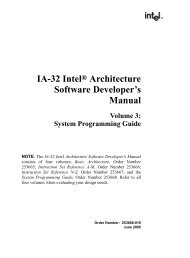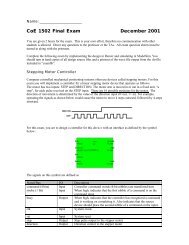Gentoo Linux AMD64 Handbook
Gentoo Linux AMD64 Handbook
Gentoo Linux AMD64 Handbook
Create successful ePaper yourself
Turn your PDF publications into a flip-book with our unique Google optimized e-Paper software.
Preparing the Disks<br />
ext3 is the journaled version of the ext2 filesystem, providing metadata journaling for fast recovery<br />
in addition to other enhanced journaling modes like full data and ordered data journaling. It uses an<br />
HTree index that enables high performance in almost all situations. In short, ext3 is a very good and<br />
reliable filesystem. If you intend to install <strong>Gentoo</strong> on a very small disk (less than 4GB), then you'll<br />
need to tell ext3 to reserve enough inodes when you create the filesystem. The mke2fs application<br />
uses the "bytes-per-inode" setting to calculate how many inodes a file system should have. By running<br />
mke2fs -j -T small /dev/ the number of inodes will generally quadruple for a given file<br />
system as its "bytes-per-inode" reduces from one every 16kB to one every 4kB. You can tune this<br />
even further by using mke2fs -j -i /dev/.<br />
ext4 is a filesystem created as a fork of ext3 bringing new features, performance improvements and<br />
removal of size limits with moderate changes to the on-disk format. It can span volumes up to 1 EB and<br />
with maximum file size of 16 TB. Instead of the classic ext2/3 bitmap block allocation ext4 uses extents<br />
[http://en.wikipedia.org/wiki/Extent_%28file_systems%29], which improve large file performance<br />
and reduce fragmentation. Ext4 also provides more sophisticated block allocation algorithms (delayed<br />
allocation and multiblock allocation) giving the filesystem driver more ways to optimise the layout<br />
of data on the disk. The ext4 filesystem is a compromise between production-grade code stability and<br />
the desire to introduce extensions to an almost decade old filesystem. Ext4 is the recommended allpurpose<br />
all-platform filesystem.<br />
JFS is IBM's high-performance journaling filesystem. JFS is a light, fast and reliable B+tree-based<br />
filesystem with good performance in various conditions.<br />
ReiserFS is a B+tree-based journaled filesystem that has good overall performance, especially when<br />
dealing with many tiny files at the cost of more CPU cycles. ReiserFS appears to be less maintained<br />
than other filesystems.<br />
XFS is a filesystem with metadata journaling which comes with a robust feature-set and is optimized<br />
for scalability. XFS seems to be less forgiving to various hardware problems.<br />
Applying a Filesystem to a Partition<br />
To create a filesystem on a partition or volume, there are tools available for each possible filesystem:<br />
Filesystem<br />
ext2<br />
ext3<br />
ext4<br />
reiserfs<br />
xfs<br />
jfs<br />
Creation Command<br />
mkfs.ext2<br />
mkfs.ext3<br />
mkfs.ext4<br />
mkreiserfs<br />
mkfs.xfs<br />
mkfs.jfs<br />
For instance, to have the boot partition (/dev/sda1 in our example) in ext2 and the root partition<br />
(/dev/sda3 in our example) in ext4 (as in our example), you would use:<br />
Example 4.17. Applying a filesystem on a partition<br />
# mkfs.ext2 /dev/sda1<br />
# mkfs.ext4 /dev/sda3<br />
Now create the filesystems on your newly created partitions (or logical volumes).<br />
Activating the Swap Partition<br />
mkswap is the command that is used to initialize swap partitions:<br />
30
















